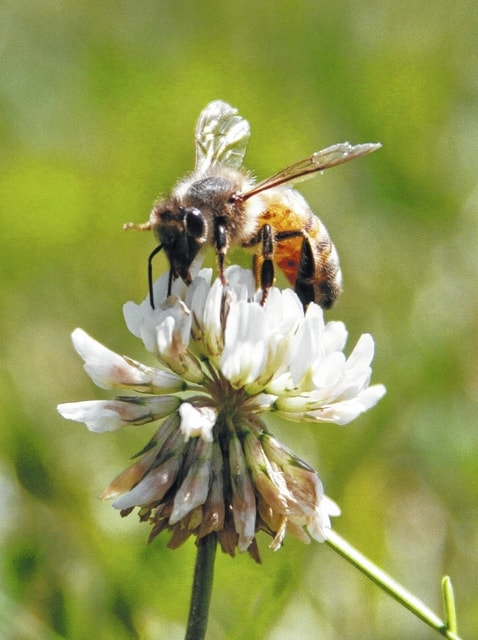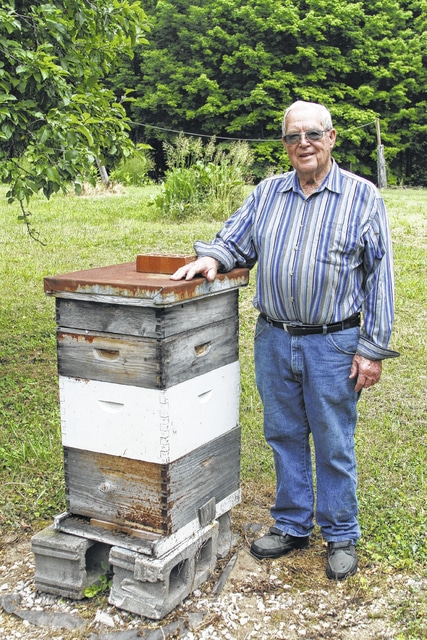

SIDNEY — Summer is officially here, a time when many are engaged in a host of outdoor activities and chores and though people are hard at it they’re not the only ones who are busy — the lawnmowers are humming, but so are the bees!
Yes, long before folks began thinking about outside chores in the spring, honeybees were already busy cleaning up their hives after the cold winter months making preparations for another season. Honeybees are fascinating creatures to say the least and anyone taking the time to study their habits will be amazed with the unexplainable complexity and efficiency in how they conduct business. Beekeeping is an interesting and rewarding activity, for some it is a hobby, for others it’s purely a business venture.
For most the mere mention of honeybees brings one thing to mind, honey; the sweet golden nectar that has been prized since the dawn of time and was once the major source of sweetener long before the days of processed sugar as noted by a local veteran beekeeper, Forrest Phillips.
Phillips was born in 1932 and grew up in tough times in the hills of Kentucky where honey was an essential part of life. He learned beekeeping from his great-grandmother and said “I can’t remember a time when we didn’t have honey; we could not afford store-bought sugar so we used honey instead.”
Phillips said the desperate living conditions during the Great Depression era.
“Everybody had beehives and kept a close eye on them, we put ours about 30 feet from the back door, we needed that honey to live!”
Hives were typically made from hollow pieces of a poplar tree about 3 to 4 feet in length and were set upright on a flat rock with three holes bored in the side of the log near the base to allow the bees access to come and go. About half way up the log four holes were bored to allow the insertion of two sticks that formed an “X” inside the log and a flat rock was placed on top of the log for a lid.
His earliest recollections of “robbin’ the hives” for honey at age 7 found Phillips smoking the hives to calm the bees. This chore was usually left to the kids who rolled up an old scrap piece of overalls, lit it on fire and blew smoke from the smoldering material into the top of the hive. After the bees settled down they opened the top and removed the honey.
“We only took the honey we found above the sticks on the inside leaving the bottom comb for the bees, the queen stayed down low and that way they would keep making more bees and more honey and fill up the top again for the next time we robbed it,” he said.
The bees were respected for their contribution and received constant attention whether for the health of the hive or just for the enjoyment of observing them. Forrest recalled watching the bees with the men folk on Sunday after church let out.
“My uncle set his hives in a big circle and we would all take a chair out and sit in the middle of those hives and watch the bees work” he said. “Heck, we didn’t have a radio until 1941, and there was no television, so we watched bees and talked instead … they never had any books or videos about bee’s but them old boys knew more about bee’s than anyone!”
Phillips moved to Sidney to find work in 1952, he found a job … and a beautiful wife and was soon busy “just making a living like everyone else.” Phillips was not afraid to work; a multi-talented individual he worked at a variety of places including Monarch Machine and Copeland Refrigeration, for a while he was also the manager of Johnson’s Cafeteria. He finally settled in for a long stint at Stolle Corp. where he worked as a tool maker and tool-room foreman until retirement.
During that those years he didn’t have a lot of time for beekeeping, but in 1981 his love for bees led him to set up a couple of hives and he joined a local beekeepers group headed up by Cable Pepper. Phillips remembers Art Brauns and a host of others including Judy Bell, who was the bee inspector at the time.
“We sure had a lot of fun at our meetings, we shared information and did what we could to help each other with problems that would arise with our bees. Before long I had quite a few hives; we sold honey, we gave some away, we never knew where it might end up” he said.
Phillips kept the hives going for a long time but now has only two working hives left and is passing them on to his grandson who will carry on the family tradition of beekeeping.
It’s not for everyone; however, the number of beekeepers has risen dramatically in recent years as have concerns about low bee numbers and the disappearance of honeybees in general. It is estimated that 70 percent of the food supply is dependent upon honeybees in one way or another. And while there are obvious ways people profit from keeping bees like honey production and pollination
Phillips said another benefit of beekeeping most overlook.
“You can get a good education from bees; they survive because they are organized, they work hard and save up for the future, there are no free-loaders in a bee hive. Everything they do has a purpose, nothing goes to waste, and all contribute to the overall health of the hive,” said Phillips. “If people were like bees our cupboards would be full, our family life and homes would be in good order, and we’d all get along with each other … and … nobody would want due to the surplus at hand!”
Note: While bees tend to be intimidating to most, some relish the opportunity to work with them. Anyone wanting a swarm of honeybees removed from their property can call the writer at 937-492-7034 for help in relocating the bees.



